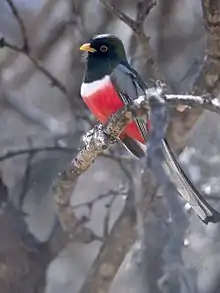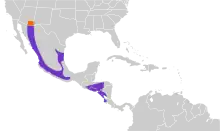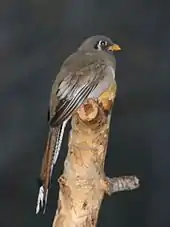Elegant trogon
The elegant trogon (Trogon elegans), previously known as the coppery-tailed trogon, is a near passerine bird in the trogon family native to Central America.[3] The etymology of the word trogon comes from the Greek word trōgein, meaning "to gnaw",[4] which describes how this species prepares its nests in trees.
| Elegant trogon | |
|---|---|
 | |
| Male | |
| Scientific classification | |
| Domain: | Eukaryota |
| Kingdom: | Animalia |
| Phylum: | Chordata |
| Clade: | Dinosauria |
| Class: | Aves |
| Order: | Trogoniformes |
| Family: | Trogonidae |
| Genus: | Trogon |
| Species: | T. elegans |
| Binomial name | |
| Trogon elegans Gould, 1834 | |
 | |
| Synonyms | |
|
Trogon ambiguus Gould, 1835 | |
Taxonomy
T. elegans has five recognized subspecies, including the nominate subspecies:[3]
- T. e. elegans Gould, 1834
- T. e. ambiguus Gould, 1835
- T. e. canescens Van Rossem, 1934
- T. e. goldmani Nelson, 1898
- T. e. lubricus J. L. Peters, 1945
BirdLife International and Handbook of the Birds of the World consider T. e. ambiguus to be its own species, as Trogon ambiguus, with Trogon elegans sensu stricto being the Central American population. The IUCN Red List follows this taxonomy, but Avibase and Clements do not.[2][5]
Phylogenetic research suggests a monophyly with T. rufus, T. mexicanus, T. personatus, T. aurantiiventris, and T. collaris. The distribution of their ancestors was restricted to the new world. However, the presence of trogons in the old world has led to debate on their true origin, which remains unknown to this day.[6]
Description
This species is a medium-sized bird, measuring 28–30 centimetres (11–12 in) long and weighing 60–78 grams (2.1–2.8 oz) (average 68 grams (2.4 oz)). Like other trogons, elegant trogons display sexual dimorphism, where males and females have different plumages.

Males are often brightly colored. They have red-orange lower chest and belly and metallic deep green back. They get their old name from the copper shade on their backsides. Their face and throat are a dark black and they have a white band going across the chest. Their upperwings are grey and their long square tipped tail feathers are usually brown on the upper side and white undertail with and black horizontal stripes.[7] The color on the upper part of the tail may very amongst subspecies.
Females and immature males look similar. They have the same patterns as mature males, but they have different colorations. Their coloration is duller, usually a brownish grey, and they have a white ring around their eyes.
Conservation
The elegant trogon is listed as endangered in the state of New Mexico. It prefers to live in conditions that would favor the presence of pine oak woodlands and local water making it particularly susceptible to disturbance.[8]
However, according to the IUCN red list, the elegant trogon is listed as being of least concern, as of 2020. Although population trends are declining, there is no sign that the species in threatened or endangered in most of its habitat.[9]
Behavior
Interactions between individuals is not rare. Research found that other than producing calls, tail movement was also a method of communication amongst individuals. Tail rising could be a sign of dominance or aggression to communicate status, or associated with mating. Another use of tail raising when its done in the presence of other species is typically done in the presence of predators, as an alarm or deterrent to let the predator know that it has been spotted and should give up the chase.[10]
Call
The usual call is a croaking "co-ah co-ah co-ah". The trogon will also include some chattering notes. Males tend to be more vocal than females.[11]
In males, the amount of calls did not vary according to the seasons, but in females, call frequencies during incubation periods were higher compared to during feeding season.[12]
Diet
The elegant trogon is a frugivore and insectivore, meaning the consume fruits and insects. Their broad bills and weak legs reflect their diet and arboreal habits. Their diet consists of grapes, cherries, figs, chokecherry, and buckthorn as well as grasshoppers, mantids, caterpillars, moths and beetles.[13] Very occasionally it will also prey upon small vertebrates, usually lizards.[14]
Although their flight is fast, they are reluctant to fly any distance. They typically perch upright and motionless. To hunt their prey, they remain motionless on a perch, then jump into flight. To grab fruits, they will hover over the berries to pluck them [14][15]
Reproduction
It nests 2–6 metres (7–20 ft) high in an unlined shallow cavity, usually selecting an old flicker hole, with a typical clutch of 2–3 eggs. Incubation periods last an average of 17 days with both parents taking turns to incubate.
Elegant trogons display biparental care, where both the males and females are responsible of taking care of their offspring. Both parents take responsibility for delivering food to their young. Usually, they would offer insects, rather than fruits. Both parents feed their offspring until a month after they fledge. Once that happens, the adults will split their broods, with males taking the males and females taking the females.[11][12]
Distribution and habitat
Along with the eared quetzal, it is the northernmost species of trogon in the world. The species is endemic to Central America, ranging from Guatemala in the south as far north as the upper Gila River in Arizona and New Mexico. Elegant trogons are short distance migrators, usually only getting as north as Arizona, where they spend the breeding season.[11] The most northerly populations of the subspecies T. e. ambiguus are partially migratory,[16] and the species is occasionally found as a vagrant in southeasternmost and western Texas. It is a resident of the lower levels of semi-arid open woodlands and forests.
The elegant trogon is fond to dry, arid woodlands. It can be found in pine forests, deciduous forests, second growth forests and around scrubs. The elegant trogon is not fond of humid regions, and choses to on hillsides near cliff edges.[17]
In Arizona, they are present in canyons covered with riparian and edge vegetation. Plants such as junipers, oaks, sycamores, and Pinus edulis can be a good indication of suitability for the trogon.[13]
References

- BirdLife International (2016). "Trogon elegans". IUCN Red List of Threatened Species. 2016: e.T22726830A94932954. doi:10.2305/IUCN.UK.2016-3.RLTS.T22726830A94932954.en. Retrieved 12 November 2021.
- BirdLife International (2016). "Trogon elegans". IUCN Red List of Threatened Species. 2016: e.T22726838A94933157. doi:10.2305/IUCN.UK.2016-3.RLTS.T22726838A94933157.en. Retrieved 17 November 2022.
- "Trogon elegans Gould, 1834". Integrated Taxonomic Information System. Retrieved 4 May 2011.
- "Definition of TROGON". www.merriam-webster.com. 2023-09-19. Retrieved 2023-10-18.
- "Trogon elegans (Elegant Trogon) - Avibase".
- Moyle, Robert G. (2005-03-21). "Phylogeny and biogeographical history of Trogoniformes, a pantropical bird order: PHYLOGENY OF TROGONIFORMES". Biological Journal of the Linnean Society. 84 (4): 725–738. doi:10.1111/j.1095-8312.2005.00435.x.
- Kunzmann, M. R.; Hall, Linnea S.; Johnson, R. Roy (1998). "Elegant Trogon (Trogon elegans)". The Birds of North America Online. doi:10.2173/bna.357.
- Hall, Linnea S.; Mannan, R. William (April 1999). "Multiscaled Habitat Selection by Elegant Trogons in Southeastern Arizona". The Journal of Wildlife Management. 63 (2): 451–461. doi:10.2307/3802630. JSTOR 3802630.
- BirdLife International. (2021). "Trogon elegans". IUCN Red List of Threatened Species. 2021: e.T22726830A168872010. doi:10.2305/IUCN.UK.2021-3.RLTS.T22726830A168872010.en. Retrieved 18 October 2023.
- Bitton, P.-P.; Doucet, S. M. (2014-01-01). "A multifunctional visual display in elegant trogons targets conspecifics and heterospecifics". Behavioral Ecology. 25 (1): 27–34. doi:10.1093/beheco/art065. ISSN 1045-2249.
- Hall, Linnea Suzanne (1996). Habitat selection by the elegant trogon (Trogon elegans) at multiple scales (Thesis). ProQuest 304305976.
- Hall, Linnea S. (January 1996). "Breeding Behavior of Elegant Trogons in Southeastern Arizona". The Auk. 113 (1): 143–150. doi:10.2307/4088942. JSTOR 4088942.
- "Elegant Trogon Life History, All About Birds, Cornell Lab of Ornithology". www.allaboutbirds.org. Retrieved 2023-10-18.
- "Elegant Trogon". American Bird Conservancy. Retrieved 2023-10-18.
- "Elegant Trogon Identification, All About Birds, Cornell Lab of Ornithology". www.allaboutbirds.org. Retrieved 2023-10-18.
- Elegant Trogon at Encyclopedia of Life
- Kunzmann, M. R.; Hall, Linnea S.; Johnson, R. Roy; Williams, Nathan R. (2020). "Elegant Trogon (Trogon elegans), version 1.0". Birds of the World. doi:10.2173/bow.eletro.01species_shared.bow.project_name. ISSN 2771-3105.
- A Guide to the Birds of Costa Rica by F. Gary Stiles, Alexander F. Skutch, ISBN 0-8014-9600-4
- Trogons And Quetzals Of The World by Paul A. Johnsgard, ISBN 1-56098-388-4
